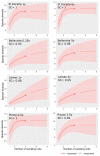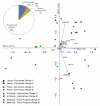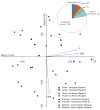Beta Diversity of Arbuscular Mycorrhizal Communities Increases in Time after Crop Establishment of Peruvian Sacha Inchi (Plukenetia volubilis)
- PMID: 36836309
- PMCID: PMC9966307
- DOI: 10.3390/jof9020194
Beta Diversity of Arbuscular Mycorrhizal Communities Increases in Time after Crop Establishment of Peruvian Sacha Inchi (Plukenetia volubilis)
Abstract
(1) Background: Beta diversity, i.e., the variance in species compositions across communities, has been pointed out as a main factor for explaining ecosystem functioning. However, few studies have directly tested the effect of crop establishment on beta diversity. We studied beta diversity patterns of arbuscular mycorrhizal (AM) fungal communities associated to sacha inchi (Plukenetia volubilis) after crop establishment. (2) Methods: We molecularly characterized the AM fungal communities associated to roots of sacha inchi in plots after different times of crop establishment, from less than one year to older than three. We analyzed the patterns of alpha, beta, and phylogenetic diversity, and the sources of variation of AM fungal community composition. (3) Results: Beta diversity increased in the older plots, but no temporal effect in alpha or phylogenetic diversity was found. The AM fungal community composition was driven by environmental factors (altitude and soil conditions). A part of this variation could be attributed to differences between sampled locations (expressed as geographic coordinates). Crop age, in turn, affected the composition with no interactions with the environmental conditions or spatial location. (4) Conclusions: These results point out towards a certain recovery of the soil microbiota after sacha inchi establishment. This fact could be attributed to the low-impact management associated to this tropical crop.
Keywords: Plukenetia volubilis; T-RFLP; agroecosystem; arbuscular mycorrhizal fungi; community assembly.
Conflict of interest statement
The authors declare no conflict of interest. The funders had no role in the design of the study; in the collection, analyses, or interpretation of data; in the writing of the manuscript; or in the decision to publish the results.
Figures







References
-
- Hamaker B.R., Valles C., Gilman R., Hardmeier R.M., Clark D., García H.H., Gonzales A.E., Kohlstad I., Castro M., Valdivia R., et al. Amino acid and fatty acid profiles of the Inca peanut (Plukenetia volubilis) Cereal Chem. 1992;69:461–463.
-
- Gillespie L.J. A synopsis of neotropical Plukenetia (Euphorbiaceae) including two new species. Syst. Bot. 1993;18:575–592. doi: 10.2307/2419535. - DOI
-
- Del-Castillo A.M.R., Gonzalez-Aspajo G., Sánchez-Márquez M.F., Kodahl N. Ethnobotanical Knowledge in the Peruvian Amazon of the Neglected and Underutilized Crop Sacha Inchi (Plukenetia volubilis L.) Econ. Bot. 2019;73:281–287. doi: 10.1007/s12231-019-09459-y. - DOI
-
- Chirinos R., Zuloeta G., Pedreschi R., Mignolet E., Larondelle Y., Campos D. Sacha inchi (Plukenetia volubilis): A seed source of polyunsaturated fatty acids, tocopherols, phytosterols, phenolic compounds and antioxidant capacity. Food Chem. 2013;141:1732–1739. doi: 10.1016/j.foodchem.2013.04.078. - DOI - PubMed
LinkOut - more resources
Full Text Sources

